It has been widely reported that the V-22 Osprey will resume testing in May 2002. However, the big surprise is that no redesigned V-22s are ready for testing. According to the April 2002 V-22 Report to Congress - pdf (it's not blank, click down after it loads), the only modification to the new test V-22s over the last 16 months was to strengthen the hydraulic lines and upgrade software. The actual V-22 redesign will occur in three stages over the next six years, in Blocks A, B, & C. Block A aircraft will not be ready for flight testing until the end of 2003, and the final Block C changes will not be done until 2008, assuming no delays occur. Operational Evaluation by Marine crews are tentatively scheduled to start in FY2005.
This is why the Bell-Boeing team and some Marine Generals
continually emphasize that testing has no timelines, and will be "event
driven" and not "schedule driven". In fact, they've established a scheme where NAVAIR (the
Naval Aviation development section) must approve each phase of testing to
certify safety. The report to Congress lays this out in section 3.2.10.3
where NAVAIR must "assess operational risk factors before authorizing
increased risk flights (e.g. assaults, night flying, weather
flying)." 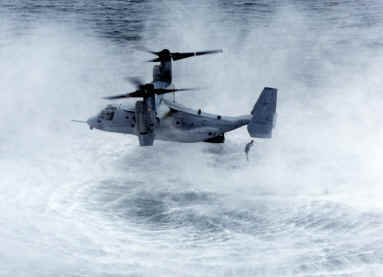
Last year, there were many statements that aggressive flight testing to determine if the V-22 was safe would begin in April 2002, which became April 29, then May 10. The Report to Congress reveals that flight testing will not begin until August 2002. NAVAIR explained that pilot requalification will take three months. However, since the final redesigned V-22 will not be ready until 2008, any real testing may be "unsafe", and could result in a career-ending crash for senior officers at NAVAIR. So the V-22 will simply repeat the same "safe" tests that were performed in the 1990s, and if anyone asks why serious tests have not been conducted, they can point at NAVAIR, and claim the moral high ground of "Safety First". Even if a V-22 crashes during regular flights, they can point out it was the "old" V-22 design, and the problem is being corrected. Meanwhile, another $12 billion will flow into the pockets of Bell-Boeing over the next six years while dozens of new V-22s roll off the production line and into storage hangers.
Brownout testing
Since the V-22's small rotors produce three times more downwash than helicopters, many pilots have expressed concern about "brownouts", which occur when dirt and dust fill the air blocking all vision. (note the water in the photo above) The US military has damaged several helicopters in Afghanistan when hard landing occurred due to brownouts. The extent of this problem with the V-22 appears serious, but according section 3.2.6.2 of the Report to Congress: "The planned development testing does not include unimproved site ops where brownout is typically encountered..." The reports suggests that brownouts can be avoided by using "non-hover landings."
Air Combat Maneuvering
One of the problems of the V-22 is that its unstable design does not allow it to maneuver aggressively in hostile landing zones. Section 5.5.1.2 of the Report to Congress states this problem has been solved. The Bell-Boeing team pressured the Department of Defense to create a term, "Defensive Maneuvering; which is defined as "...maneuvers performed within the design specifications of the aircraft performance " In short, if something can fly, it's ready for combat.
The V-22 Redesign Ignores Vortex Ring Problem
Experts were unable to develop a solution to the Osprey's fatal "vortex ring" problem, which causes the V-22 to fall from the sky if it descends too fast at slow speeds. The real problem is stalling one of the asymmetric rotors , just like stalling a wing of an aircraft, but calling the problem "vortex ring" is preferred by Bell-Boeing since it sounds minor. They concluded that a device which can measure low forward air speeds could help the pilot avoid this fatal problem, and recommended developing a prototype. (see Section 3.2.35 of the Report to Congress.)
The February 2002 issue of Armed Forces Journal, explains: "since the V-22 has asymmetric rotors on its wing tips, if one of them encounters the vortex ring state phenomenon before the other, the aircraft will be inclined to roll over. That's one of the reasons why V-22s are presently limited to a rate of descent of less than 800 feet per minute. While that would be adequate for a commercial operation, it's far short of what the military needs -- several thousand feet per minute -- during tactical insertions." This was hidden in an article about Optical Air Data Systems, where Phil Rogers describes his efforts to save the V-22 program. Rogers said: "Right now, there's nothing that can measure low forward speeds -- below 40 knots -- accurately enough to let them get to that envelope, but not into it. The standard pneumatic systems that are used for that purpose are not sensitive enough to measure below 40 knots. The other problem with pneumatic systems is that they are in the rotor wash. So unless you have a high forward speed, the rotor wash dominates any measurements that are made."
Rogers' company is conducting a feasibility demonstration to determine if a laser can measure low forward air speed. This story reveals that after 20 years of tiltrotor development, and two years after the vortex ring state problem was proven a fatal flaw, no solution has been developed. V-22 pilots cannot rapidly descend for combat missions because no instrument can accurately measure forward airspeed to warn them they may flip over. Until this problem is solved, there is no point in restarting V-22 testing, or continuing to build flawed V-22s. This problem has already been studied for years and the only hope is a laser theory which has produced a "feasibility study". In short, a laser measurement device may be perfected within a few years, which may help pilots avoid the V-22's fatal vortex ring problem. Meanwhile, combat maneuvering will not be tested in the V-22 because NAVAIR will rule it unsafe until a low forward airspeed measurement device is invented.
The V-22's NATOPS (operating manual) used by ALL pilots of the V-22 clearly states on Page I-4-13, WARNING "Air Combat Maneuvering and Aerobatics are PROHIBITED." This is a simple and direct mandate. There is little room for argument. It is in essence a form of regulation, the violation of which can lead to an investigation by the Navy JAG, along with some form of punishment, transfer, loss of ratings -- or worse. NATOPS provides further evidence that the "Flight Envelope" of the V-22 is highly restrictive, with words such as:
"During Maneuvering at low
airspeed, Accelerated Stall can be achieved at moderate bank angles and/or load
factor."
"Because of the inherent instability of the tiltrotor
---"
"Potential energy cannot be stored in the propulsion system" (as helicopters
do)
"Practice Autorotations, to include entry or glide , are PROHIBITED"
"Abrupt multi-axis control inputs are PROHIBITED"
Here are more worrisome NATOPS extracts - pdf These limits are an admission that the V-22's fundamental instability problems remain, so pilots are directed not to make abrupt movements or descend rapidly, lest they roll over and drop from the sky. When a US Army MH-47 helicopter was hit by a small rocket while landing in Afghanistan, the pilot yanked the stick so abruptly to escape that a Navy SEAL was thrown out the back ramp. If this were a V-22, the pilot would have crashed the entire aircraft, killing everyone on board because: "Abrupt multi-axis control inputs are PROHIBITED"
The Osprey is unarmed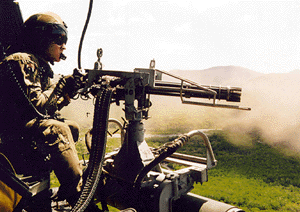
Even if a new device allows a V-22 to safely and SLOWLY descend into a combat landing zone; this is where 91% of combat losses occur. Transports have a "door gunner" on each side who shoot a rapid-fire machine gun (called mini-guns, right) at enemy positions below to "suppress" enemy fires. When several helicopters land in formation, the volume of fire pouring down is impressive. However, the V-22 will have no door gunners because the tandem rotor design blocks half their view and field of fire. No one wants a door gunner attempting to shoot around a massive rotor and wing sticking out the side of an aircraft; the rotor wash would affect his accuracy anyway.
The V-22 program has dodged this issue. The
original explanation was that it could be added later in the program. In
the 1990s, they  convinced Marine
Corps leaders that a gun could make the pilot too aggressive, thus endangering
his passengers. When General Jones become Commandant in 1999, he insisted
the V-22 must have a gun to provide suppressive fire. As a result, Jones
was told a rapid fire GAU-19 .50 caliber machine gun would be mounted on a
turret under the
nose and fired by the co-pilot. (similar to the 20mm gun on the Cobra attack
helo at left) This is not a simple task since the 608lbs GAU-19 with
several hundred rounds of ammunition and the electric pivoting nose chin will
take a lot of space under the crowded cockpit. The extra of weight and
bulbous chin will also reduce speed and performance.
convinced Marine
Corps leaders that a gun could make the pilot too aggressive, thus endangering
his passengers. When General Jones become Commandant in 1999, he insisted
the V-22 must have a gun to provide suppressive fire. As a result, Jones
was told a rapid fire GAU-19 .50 caliber machine gun would be mounted on a
turret under the
nose and fired by the co-pilot. (similar to the 20mm gun on the Cobra attack
helo at left) This is not a simple task since the 608lbs GAU-19 with
several hundred rounds of ammunition and the electric pivoting nose chin will
take a lot of space under the crowded cockpit. The extra of weight and
bulbous chin will also reduce speed and performance.
The past 16-month delay for the V-22 redesign was the ideal time to add the gun into the test aircraft. This is important because the gun's weight and vibration while firing will affect aircraft performance. Since the GAU-19 is a proven gun, there is no reason to delay. However, testing will resume without the GAU-19. In fact, the current plan delays adding the gun until the very end of testing in 2008. The Bell-Boeing team may imply the GAU-19 is something which can just be bolted on at the very end. If its that simple, why not bolt it on now? Obviously, there is a major problem with adding the GAU-19, so Bell-Boeing will continue to dodge this issue until it goes away. As a result, if a safe V-22 is ever developed, it will fly into combat completely unarmed. Since the V-22s are much faster than the Cobra attack helicopters that escort transports, they will have to fly as slow as helicopters and negate their only advantage.
The Tilt-rotor may Tilt sideways aboard ship
While in flight "the location of the engines, gear boxes and rotors at the wing tips causes relatively high roll and yaw inertia". This is a direct quote from NATOPS section 9.2. This also causes serious problems aboard ship. The roll of a ship or gusts from nearby aircraft can cause a V-22 on ship to tilt over on the deck and squash sailors and Marines nearby. A NAVAIR report by Kurt Long -pdf states this danger is "VERY significant" and "...could prohibit ALL shipboard ops." This problem was ignored in the redesign because no solution exists.
STOL Payload and Range
Most people are confused by the V-22's payload and range. For example, why can it lift 20,000lbs of payload internally, but only 15,000 externally. Here are the official maximum take-off weights:
47,500 lb Vertical Takeoff/Landing (VTOL)*55,000 lb Short Takeoff/Landing (STOL)
60,500 lb Self Deploy STO
*Last year, the new V-22 project manager inexplicitly raised the max VTOL weight to 52,600, while the V-22 was grounded.
Apparently, if the V-22 must take off vertically like a helicopter, its maximum take-off weight drops by 7500lbs. When operating from large land bases, STOL "rolling" short take-offs are no problem. STOL take-offs from LHA/LHD carriers are possible if the deck is cleared. However, this becomes very difficult during amphibious operations when 30 other aircraft are operating from a ship. In Fleet operations, no one will ever attempt a rolling take-off with a heavy payload because cargo comes in many sizes and forms, and mistakes about weight are common. A helicopter or V-22 attempting to lift something vertically quickly learns he cannot lift off, so they off-load some weight. However, an overloaded V-22 attempting a rolling STOL take-off, or one whose engines are not providing 100% power, may roll off the deck and plunge into the sea. The first time that happens, rolling V-22 take-offs from ships will be banned forever. AV-8B Harrier jets make rolling take-offs all the time, but they have wings for added lift, know exactly how much their fuel and ordnance weighs, and can eject if problems develop.
So whenever Bell-Boeing mentions the V-22 range or payload, they are probably assuming STOL. A report on the V-22 sea trials by V-22 test pilot LtCol John Rudzis reveals the maximum STOL take-off weight attempted was only 47,300 lbs, nearly 8000lbs less than advertised. He also mentioned that : "A left seat landing under relative winds over deck of 355 deg relative and twenty-five knots resulted in a roll excursion of thirty-seven degrees angle of bank while only ten feet above the deck level. Only that the left rotor was over the water and full power had been applied to initiate a climb, prevented the nacelle or rotor from impacting the ship. Further testing in these conditions was suspended until this event could be thoroughly investigated."
Fewer V-22s can fit on ship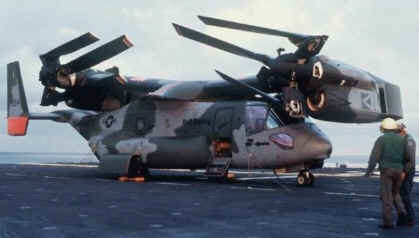
Few people realize the V-22 weighs almost as much as the powerful CH-53E, which can carry twice as much. The V-22 can automatically perform a contortionist routine to save space, although maintenance officers cringe when shown the photo at right. They know that after a few years of wear and countless automatic folds, every moving part eventually breaks.
 Nevertheless, Navy ships can only carry so much weight before they become
unstable. This is particularly important for objects high on ship, like on
the flight deck. As a result, some Marine leaders have just discovered the
Corps cannot deploy twelve V-22s aboard ship with a standard MEU composite squadron.
So assuming that V-22s ever become safe, a MEU can deploy with no more than
eight V-22s, instead of today's twelve smaller CH-46Es. Actually, the CH-46E
has more internal cargo space than the V-22, it just weighs much less.
Nevertheless, Navy ships can only carry so much weight before they become
unstable. This is particularly important for objects high on ship, like on
the flight deck. As a result, some Marine leaders have just discovered the
Corps cannot deploy twelve V-22s aboard ship with a standard MEU composite squadron.
So assuming that V-22s ever become safe, a MEU can deploy with no more than
eight V-22s, instead of today's twelve smaller CH-46Es. Actually, the CH-46E
has more internal cargo space than the V-22, it just weighs much less.
This is why the LHA/LHD Replacement program recently emerged. Some people want to spend billions of dollars to design a new class of bigger flattop amphibs just to carry a MEU composite squadron with twelve V-22s, rather than continuing to buy modern LHDs. The LHDs are already larger than any World War II aircraft carriers, and larger than any foreign aircraft carriers. Even if this expensive idea for larger ships is adopted, it will be ten years before the first appears in the Fleet, and 35 years before the last "undersized" LHD retires, along with the last V-22s.
Bell and Boeing Lack Confidence in
Tiltrotors 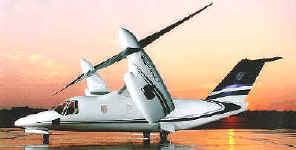
One of the selling points for the V-22 is that tiltrotor technology will revolutionize civilian aviation. Bell teamed up with Augusta several years ago to produce a smaller tiltrotor, called the BA609 (photo of mock-up at right). They decided to use the standard 3000psi hydraulic system, rather than the new 5000psi system which has plagued the V-22. Many were surprised the V-22 redesign kept the leak-prone 5000psi system.
Bell claimed to have orders for 80 BA609 aircraft for VIP use, which doesn't require as stringent safety specifications as passenger aircraft FAA certified for commercial use. When the V-22 crashes raised questions about the safety of the tiltrotor, Bell did not press on with the BA609 to demonstrate its confidence in tiltrotor technology. Instead, Bell halted plans to begin BA609 flight tests and seek FAA certification, and recently stopped all work on the BA609.
Boeing is the world's largest maker
of commercial aircraft. Why isn't Boeing marketing a commercial version of
the V-22? This would not require research, testing, or development
funding. They can simply put passenger seats in V-22s which can come off the
established production line and sell them to airlines, just as companies have
done with military helicopters. However, Boeing has made no effort to
market a commercial version of the V-22. Why?
Helicopter expert Harry Dunn says the reason is the V-22 can never pass FAA safety tests due to its unstable design. Meanwhile, Boeing is working on a new VTOL canard wing design where the entire wing can also spin like a big helicopter blade (left). So if tilt-rotor technology is safe and revolutionary, why has it been dismissed by every foreign and domestic aircraft maker, including Bell and Boeing, the makers of the V-22? The Russians built two tiltrotor prototypes for testing, and determined the concept was unsafe. Why has the V-22 been rejected by the US Army, US Coast Guard, and recently the US Navy? The US Air Force is still officially in the program only because Congress adds money each year for the CV-22.
Meanwhile, Bell-Boeing has been sued by several family members of those killed by the V-22 whose lawyers said they could prove that executives knew the V-22 was unsafe. Bell-Boeing denied this charge, yet refused a chance to refute these charges in open court and settled each case, all with a confidentially agreement which required that facts be withheld from the public.
The Navy MH-60S is superior
Recently, Congress began asking about alternatives to the V-22. The Marine Corps dodged this issue, then offered the European EH-101 as a possibility, knowing that Congress would never support the purchase of a foreign aircraft. The Corps ignored the new Sikorsky S-92 helicopter, which has been sold to Ireland and Communist China. It claimed it would take years to develop a "navalized" version of the Army Blackhawk, ignoring the Navy HH-60H Seahawk, which has been in service for years, and an advanced version, the MH-60S Knighthawk, which just entered Navy service. The Knighthawk can carry a crew of four and 13 passengers or 10,000lbs of cargo, which is twice the payload of the older CH-60A Blackhawk in service with the US Army.
The Marine Corps can simply sign a production contract to join in
the Navy buy for Knighthawks in FY2003. Navy H-60 spare parts and training programs have been
functioning for years, and the Corps already operates eight VH-60s as part of the
Presidential helicopter squadron. If the Marine Corps joined the Army, Navy, and
Air Force by adopting the Sikorsky H-60 series for basic transport, all services
would save money and improve interoperability. This year, the Navy bought
17 MH-60S for $17 million each, they would cost even less if purchased at a
higher rate with a joint Marine Corps buy. The MH-60S can carry almost as
much as the MV-22, at one-sixth the price. The Navy is impressed
with the MH-60S and will use them to replace their CH-46D helicopters,
rather than buying 48 HV-22s.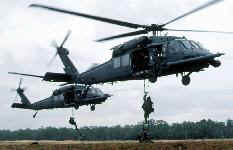
Adopting the H-60 design would allow the Marine Corps to add a new capability by modifying some MH-60S as EH-60E electronic warfare or MH-60Q Medevac helicopters, using components already in service with the Army. The Corps can also buy some MH-60Ks (right), which have larger fuel tanks and refueling probes which allow it to fly much farther than the MV-22. Another advantage is that the MH-60S is equipped to carry 16 Hellfire anti-tank missiles. This would quadruple the airborne anti-tank firepower of the Marine Corps. For example, MEU composite squadrons which the Corps maintains forward-deployed include four Cobra attack helicopters which could be supported by twelve MH-60S carrying Hellfires and machine guns.
The MH-60S Knighthawk is also far superior as an assault aircraft. First, it is smaller and thus harder to hit. Second, it can safely descend three times faster than the V-22 with no worry of flipping over. Third, it has machine guns for suppressing enemy fire. Fourth, it has side cargo doors to allow Marines to leap out immediately, rather than wait their turn to file out the back ramp of a V-22. The Army suffered many casualties using CH-47s in Afghanistan when two were shot up as soldiers waited to file out the back ramp. Fifth, the downwash from the V-22 is so bad that Marines must lie down until the V-22 leaves, and rope ladder extractions are impossible. Finally, a $17 million MH-60S is easier to replace than a $118 million V-22, which is why former Marine James Webb opposed the V-22 program in the 1980s when he was Secretary of the Navy. The US lost thousands of helicopters during the Vietnam conflict; they must be affordable. The FY 2002 budget provides $1.3 billion for 11 MV-22s ($118 million each) plus $447 million for testing (or $159 million each in annual costs). The Marine Corps could have purchased 103 MH-60S helicopters with that money.
When will the V-22 Scandal end?
The V-22 program was canceled by the
Bush administration back in 1989 after two prototype crashes. After an
extensive review, then Navy Secretary Sean OíKeefe told the House Armed
Services Committee, "The V-22 cannot be built to meet
the requirements specified. Itís an engineering impossibility."
However, politics revived the flawed program and another $10 billion was
spent on testing and development until two disastrous crashes led to the
grounding of the V-22 in December of 2000. Nevertheless, production was
authorized and four billion dollars later the
V-22 will fly again, while
performing all five phases of aircraft creation simultaneously: research, development,
testing, production, and upgrades. This bizarre arrangement
produces a new $159 million V-22 each month which is unsafe to fly. It
rolls off the assembly line and into storage awaiting upgrades, or eventual
donation to an aviation museum. Even if a safe V-22 has not
been developed by 2008, the V-22 team will argue that 100 flawed V-22s have already been built, and the Marine Corps cannot afford to cancel the program. 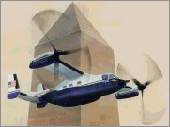
If politicians have such confidence in the V-22, why not announce the first V-22s will become part of the President's VIP helicopter squadron-HMX-1. This Marine Corps squadron has a secondary mission of testing helicopters, and flying VIPs around the East Coast is much easier for the V-22 than operating from ships or in combat zones. NAVAIR's website claims "The Osprey's size, speed, range and ability to land in tightly confined areas would create a revolution in the Executive/VIP transport role." Flying politicians around will prove their confidence in the V-22s safety, yet it's unlikely they will risk their lives in an unsafe aircraft.
Meanwhile, where are the dozens
of unflyable V-22s today? As a final example of how bad this program has
become, here is a recent Navy contract announcement.
Bell-Boeing Joint Program Office, Patuxent River, Md., is being awarded a
not-to-exceed $5,719,000 modification to a previously awarded
cost-plus-fixed-fee contract (N00019-00-C-0183) for long-term preservation and
storage of 19 V-22 aircraft until Block "A" configuration changes,
safe and operational fleet return to flight are developed and implemented on the
aircraft prior to delivery. Work will be performed in Amarillo, Texas, and
is expected to be completed by December 2002. Contract funds will not
expire at the end of the current fiscal year. The Naval Air Systems Command,
Patuxent River, Md., is the contracting activity.
That's right, taxpayers will pay Bell almost $6 million dollars to store 19 of their defective V-22s, that's $301,000 for each, just for storage. The V-22 has become the biggest scandal in US military history, with some $16 billion wasted thus far. New technology always presents problems, yet many were unsolvable so the project was cancelled. It's clear the tiltrotor idea has failed, which is why even Bell and Boeing are not building commercial tiltrotor aircraft. Every month the Bell-Boeing team can stall, it gets another $159 million, payments which are not "event driven". Unless action is taken, there is no doubt the V-22 will still be testing and developing in 2010.
Carlton Meyer editorG2mil@Gmail.com
More details about V-22 flaws can be found in two G2mil articles from last year: The V-22 Fiasco and MV-22 Lies. Many helicopter experts were so appalled by the findings of the V-22 "Blue Ribbon Panel", which was formed to keep the V-22 program going and consisted of no rotorcraft experts, they formed a "Red Ribbon Panel" to present the truth. They produced a detailed technical report on the cause of the V-22 crashes which you can read here: Red Ribbon Panel Study Their coordinator, Harry P Dunn, is a graduate of the United States Naval Academy - with several months of USMC training - and a retired Colonel in the US Air Force. He was Flight Test Director of H-3 Jolly Green Rescue helicopter and the world's first In-Flight Refueling for Helicopters Program with some 45 years of direct association with helicopter/rotorcraft/VSTOL programs. He contributed to this article and can be reached at Hpdunn@aol.com if anyone wants to discuss technical aspects as to why the V-22 is fundamentally flawed.
©2002 www.G2mil.com
Letters
UPDATE
Osprey's scheduled test flight is postponed
Plan still envisions takeoffs in May, but adjustments are needed
By RICHARD WHITTLE / The Dallas Morning News 05/09/2002
WASHINGTON Ė The V-22 Osprey's scheduled return to the sky has been put off until later this month, the program manager said Wednesday.
The Pentagon had planned to get the tilt-rotor transport back into the air on Thursday, its first flight since it was grounded after two fatal crashes. But some final mechanical adjustments have slowed the schedule, said Marine Col. Daniel Schultz, V-22 program manager.
"Our goal has always been to fly in May," Col. Schultz said. "Whether it's the first part of May or the last part remains to be seen."
"We're part of a long-term test program, and whether we fly today or three weeks from today really doesn't matter," he added, speaking by telephone from Patuxent River Naval Air Station, Md., where the tests will be conducted.
The flight testing, scheduled to last through 2003, will decide the future of the Osprey, built by Bell Helicopter Textron Inc. of Fort Worth and Boeing Co.
Undersecretary of Defense Pete Aldridge, who has authority to cancel the program, has voiced skepticism about the Osprey but said the plane could win his approval if the tests go well.
The $40 billion program has been in limbo since 23 Marines were killed in two V-22 crashes in 2000. The Marines want to replace their Vietnam-era troop transport helicopters with the Osprey, which tilts two huge wingtip rotors upward to take off and land like a helicopter and forward to fly like an airplane.
Following numerous investigations and a review by a special commission, the Osprey's flight control software has been revised. And hydraulic and electric lines in the aircraft's nacelles Ė large wingtip structures that hold the engines and rotors Ė have been rerouted to avoid chafing that was blamed for hydraulic leaks.
Col. Shultz blamed the postponement on the discovery that turning on the power in the hydraulic system had caused the lines to move slightly, much as a garden hose moves when the water is turned on.
Additional clamps and brackets were installed to solve the problem, he said. "Once we've powered the rotors up and turned the rotors, we expect to find some other things."
In any event, Col. Schultz said, "Within the next few weeks, we'll be back in the air."
Ed. Stall, stall, stall. Each month this drags
on, the Bell-Boeing team gets another $159 million. After the FY2003
budget is approved soon, a total of 62 production V-22s will have been funded.
It has always been April 2002 for testing to start; Col Shultz must have
"misstated". As for the delay, are we to believe that they did
all that work installing new hoses for 16 months and didn't start the engines to
see what happened until May? They even got the Secretary of the Navy to announce the Osprey was safe and
ready to fly on May 9th. Apparently, the SecNav doesn't read the Dallas
Morning News.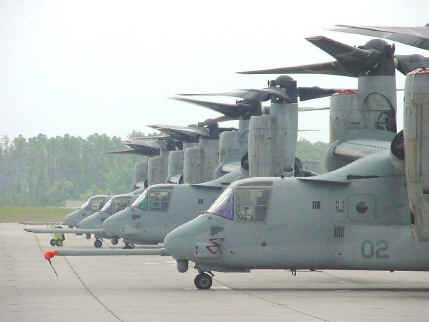
V-22 Politics
Bravo on your article and guts for taking on the
Marine Corps. I used to work for an aerospace company and made the mistake,
while talking to some staff people on the Hill, about several very negative
aspects of the V-22 program. Most specifically was its fatally flawed ability to
cope with any but the mildest form of asymmetrical thrust/lift. I got several
threats and one person had the rabid pro V-22 crowd carry a message to me to
back off. He told me that I was playing with fire and of course, my company had
some big R&D and procurement lines in the authorization and appropriations
bills every year. One colleague of mine wrote a critical letter to the editor of
an aerospace magazine and the Marine Corps wanted him fired!
The fatal design flaw is the necessity, based on rotor
diameter and wing span, to have the rotors too far apart for the torque that
they develop. Ask any Marine who flew the OV-10 Bronco (I have a lot of hours as
a FAC instructor in it) how far away from the fuselage the props are. They are
barely 6 inches and this is to reduce the effects of a loss of power, for any
reason, and particularly at low airspeeds (V-22 slowing for landing!). In
all of the accidents, and although the initial failures were all different
(Quantico "fire" in one engine) , Arizona ("loss of lift on one
rotor") and New River ("hydraulic problem"), the killer always
was the catastrophic loss of control because of asymmetric torque/thrust. And it
will always be so. Cross shafting did not work at Quantico because the coupling
had burned through, and it will never work if there is a gear box failure on
either nacelle. Combat? One 23 mm hit on an engine ought to do the whole load
in.
Sorry for the preaching, but like you, I believe that
the Marine Corps has sold its soul for a few pieces of silver (read: roles and
missions), and it is a tragedy. They now have an appalling lack of integrity.
Thank goodness my son decided to resign his commission from the Corps.
Name Withheld
V-22 Dangers
Where is the fuel intake on the V-22? If its near the wing which may see-saw while on a ships' deck, it makes hot refueling very dangerous. Will they have to chain it down each time? Even that would be hazardous. Perhaps NATOPS should have a:
WARNING: shipboard ops in bad weather or while other aircraft are flying nearby are PROHIBITED.
WARNING: this aircraft MUST be chained down before hot refueling aboard ship.
J. J.
Ed. I received a few e-mails from people VERY CLOSE to V-22 testing. They noted problems but claimed everything was being fixed. They complained about many inaccuracies in my article, but the only ones they could name were taken from their V-22 report to Congress in April of 2002. One e-mail revealed the actual payloads tested are not near those claimed. He said: "The Operational Requirements document requires the V-22 to be able to carry 8K internally and 10K externally. Thus far the V-22 has demonstrated the capability to internally carry 13K and externally lift 11K." I asked why they tell everyone it can lift 20,000 lbs internally and 15,000 lbs externally. He explained that is the goal, something I have never read anywhere. The only part I may have got wrong was claiming the term "defensive maneuvering" was invented for the V-22 program since it incapable of "combat maneuvering".Osprey's Chin Gun Can't Work
I had been a long time fan of
the Osprey since I first saw a drawing of it years ago. Being an Air
Assault infantryman, I liked the idea of getting in and on the ground faster,
and getting out faster. I still like that idea. I have a friend who
is an Air Force PJ, who was a fan of the Osprey as well. He mentioned the
fact that getting to the downed pilot as fast as possible is critical and such a
vehicle as the Osprey would be ideal.
You mention many faults of the
V-22, and I couldnít agree more. The Osprey is a huge failure. It
has become the new military icon of failure like the Sgt York was. You
canít fly it hard, you canít fight in it, you canít fight from it. I
think the best use for the V-22 should be to transport Bell/Boeing Execs and the
Military staff that are still supporting this project. Perhaps with a few
rides they will understand that this vehicle just isnít going to cut it.
Problem with that is, realization would come when itís too late and the V-22
is about to auger into the earth. Theyíll get the Darwin Awards, but
that project will still be in effect.
If it is going to be doing search and rescue, it has to have side doors. Simple as that. Door gunners too. A chin gun? Gimme a break! If I am being rescued and the baddies are on my tail Ė I want to be running to the boys that have me covered. I donít even want to be running at an aircraft with the copilot laying down suppressive fire from his vision obscured position in the cockpit!
Ed. I didn't think about the problem of a chin gun in a transport. It cannot turn toward the enemy to engage while landing, so how can the co-pilot aim the thing? With a video screen and joy stick, while he's try to help to land in the brownout without flipping over? When it lands, the gun will be less than a foot off the deck so it cannot fire unless on a flat runway.